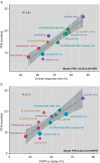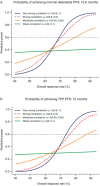Model-Based Meta-Analysis for Multiple Myeloma: A Quantitative Drug-Independent Framework for Efficient Decisions in Oncology Drug Development
- PMID: 29168990
- PMCID: PMC5867027
- DOI: 10.1111/cts.12524
Model-Based Meta-Analysis for Multiple Myeloma: A Quantitative Drug-Independent Framework for Efficient Decisions in Oncology Drug Development
Abstract
The failure rate for phase III trials in oncology is high; quantitative predictive approaches are needed. We developed a model-based meta-analysis (MBMA) framework to predict progression-free survival (PFS) from overall response rates (ORR) in relapsed/refractory multiple myeloma (RRMM), using data from seven phase III trials. A Bayesian analysis was used to predict the probability of technical success (PTS) for achieving desired phase III PFS targets based on phase II ORR data. The model demonstrated a strongly correlated (R2 = 0.84) linear relationship between ORR and median PFS. As a representative application of the framework, MBMA predicted that an ORR of ∼66% would be needed in a phase II study of 50 patients to achieve a target median PFS of 13.5 months in a phase III study. This model can be used to help estimate PTS to achieve gold-standard targets in a target product profile, thereby enabling objectively informed decision-making.
© 2017 The Authors. Clinical and Translational Science published by Wiley Periodicals, Inc. on behalf of American Society for Clinical Pharmacology and Therapeutics.
Figures




References
-
- Siegel, R.L. , Miller, K.D. & Jemal, A. Cancer statistics, 2017. CA Cancer J. Clin. 67, 7–30 (2017). - PubMed
-
- Katodritou, E. , Papadaki, S. , Konstantinidou, P. & Terpos, E. Is it possible to cure myeloma without allogeneic transplantation? Transfus. Apher. Sci. 54, 63–70 (2016). - PubMed
-
- Baz, R. et al Development of a conceptual model to illustrate the impact of multiple myeloma and its treatment on health‐related quality of life. Support Care Cancer 23, 2789–2797 (2015). - PubMed
Publication types
MeSH terms
LinkOut - more resources
Full Text Sources
Other Literature Sources
Medical
Research Materials

